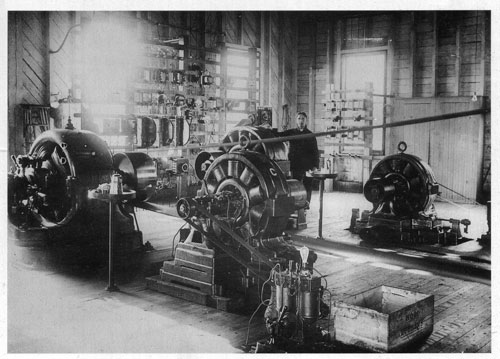B A C K T H E N
Sanford, 1892 – Another Electric Transportation Era

Inside the new power station of the Mousam River Railroad. Using waterpower to operate a vehicle, as opposed to stationary mill machinery, represented a quantum leap in power-transmission philosophy.
The Mousam River Railroad, chartered in 1889 by members of the Goodall family, owners of two large textile mills, was intened to be a steam-freight railroad connecting the mills with the Portland and Rochester Railroad. By the time construction commenced in 1892, the advantages of an electrified street railroad proved compelling. The powerhouse was equipped with four “dynamos,” including two Westinghouse 550-volt multipolar drirect-current generators. One was waterpowered, the other powered by a steam engine.1
Street-railway cars were powered by two 20-horsepower direct-current motors of remarkable durability, able to withstand counteless start-ups.2 Some are yet in use. The disadvantage with the DC power was that its range in an open wire was no more than five or ten miles. Various means were employed to deal with this shortcoming, including running large feeder cables to points along the line and producing AC current that was converted to DC current at substations.3
In 1889 the Mousam River Railroad was merged with the 20.45-mile-long Sanford and Cape Porpoise Railway, also built by the Goodalls and primarily intended to deliver coal for the mills from a wharf in Cape Porpoise Harbor.
Text by William H. Bunting from A Days Work, Part 2, A Sampler of Historic maine Photographs, 1860 - 1920, Part II. Published by Tilbury House Publishers, Gardiner, Maine. 800-582-1899
